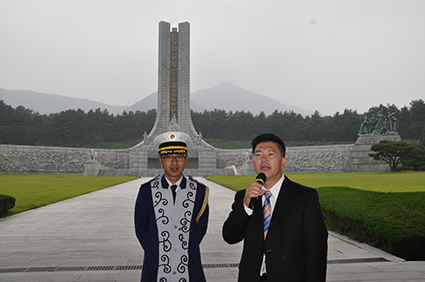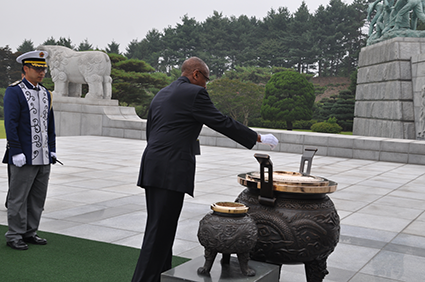
Korea, U.S., remain united in tragedy and triumph
By Melissa Lauber

Clothed in white gloves and a solemn air, Bishop Marcus Matthews marched next to a military guard through the Korean National Cemetery, leading a contingent of leaders from the Baltimore-Washington Conference, who marched behind him.
Offering a silent prayer, he added incense to a sacred flame that honored the soldiers who had died in the Korean War.
It was an act of remembrance and a nod to a common history between the people of the BWC and the South Conference of the Korean Methodist Church.

History is playing an important role on this 10-day trip to renew the partnership between the two conferences. Korea is an ancient and sacred place where even the trees have legends.
For many in the United States, Korea conjures up images of the Korean War. When the hostilities ended in 1953, Seoul, the capital city, was in ruins; little more than the river remained. In the intervening years, development that has been characterized as nothing short of miraculous has occurred. Now a city of almost 15 million residents, Seoul rivals New York City.
But the ancient lingers in the souls of many Koreans, said the Rev. J.W. Park, superintendent of the Central Maryland District, who led a group of Baltimore-Washington Conference leaders on a cultural immersion trip to Korea to renew their partnership with the Korean Methodist Church.
About two hours south of Seoul, near the city of Daejeon, the Baltimore-Washington Conference team was welcomed by members of the South Conference, at a site where tourists get their photos taken with a legendary tree that moved its branches to allow the emperor to pass.

Up the road from the Boeun Jeongipum Pine Tree, is the BeopJusa Buddhist Temple. Members of the South Conference guided 21 members of the Baltimore-Washington Conference through the sacred grounds that date back to the year 533.
Members learned how the temple bells called all people, animals, and everything under the earth to prayer twice a day and how the 1,300 monks lived in in community 1,400 years ago.
Today, about one-third of Koreans are Buddhists, fewer than one-third are Christian and more than one-third are non-religious, Park said.
Methodism came to Korea 130 years ago, brought by the missionary Henry Appenzeller. The church was alerted to the dramatic needs of the Korean people by the Rev. John Goucher, a Baltimore pastor who received a delegation from Korea who were visiting the U.S. President to plead for aid. Goucher became convinced of the need to "send the Gospel of life" to Korea.
Goucher put up $2,000 and Appenzeller began a movement that grew into the Korean Methodist Church.
In a variety of moments throughout the trip, the Baltimore-Washington Conference delegation immersed themselves in this rich history, viewing artifacts from the tomb of King Muryeong from the year 501 at the Gongju National Museum, honoring the fallen soldiers from the Korean War at the National Cemetery, and touring Pai Chai University, where several of the buildings are named for Appenzeller.
"Amid the past, is a sense of the future and a hope for how God will continue to work among the people of Korea," said Sandy Fergsuon, director of Connectional Ministries. "We find moments when we shared a common history. We look forward to creating a shared future."

Login/Register to leave comment